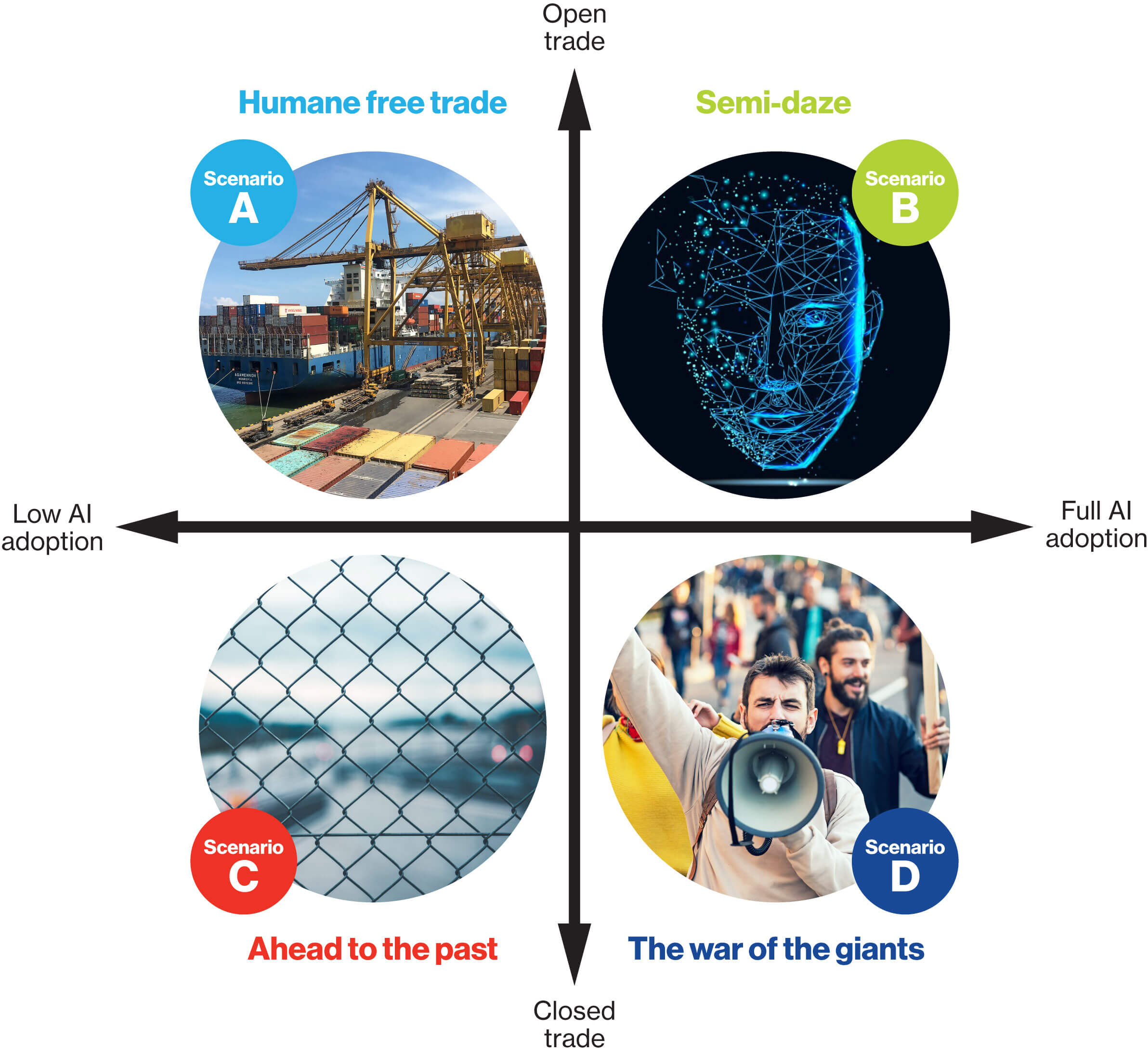Artificial Intelligence and the Global Trade Environment
Strategic Foresight
November 18, 2019
The Conference Board of Canada’s Global Commerce Centre (GCC) held a strategic foresight workshop on November 19, 2018.* Participants explored four plausible futures based on different levels of openness to global trade and adopting AI. (See matrix.)
Workshop participants developed narratives that explain how each scenario will evolve through 2035, what global value chains will look like then, what threats and opportunities Canadian businesses will face, and which regulations could best ensure AI is safely and reliably integrated in the economy.
*The workshop was conducted under the Chatham House Rule. The identity and affiliations of those who participated in the individual group discussions are kept confidential.
Matrix of four scenarios showing the intersection between AI and global trade (click image to enlarge).

Key Findings
Ethical concerns
Each group identified ethical concerns related to their respective scenario. Some of these concerns were highlighted by all four groups, such as those around the distribution of trade benefits and potential inequalities in access to AI.
Mixed impact on value chains and labour
Each group identified unique impacts on value and supply chains in Canada. The groups also indicated that the Canadian workforce will have to cope with broad economic shifts. As well, thoughtful policy approaches must be encouraged to support displaced workers during structural transitions.
Government avenues
The groups suggested that government policies address a range of issues related to AI adoption and global trade trends. Notably, participants suggested that the government:
- ensures data protections and works with its trading partners on setting protection standards to balance privacy and information flows;
- ensures that independent AI operators are not gobbled up by the tech giants;
- supports firms in their efforts to compete at the international level;
- undertakes specific sectoral analyses on potential threats and opportunities from AI adoption to ensure that AI is effectively integrated across the economy;
- integrates AI in educational and training programs;
- introduces a program to support workers when confronted with quick labour market displacements resulting from technological innovations.
Scenarios intersecting AI and global trade
Humane free trade
Low global artificial intelligence adoption and free trade global trend
Scenario narrative
The international community has decided to invest fully in deregulating trade and dismantling barriers to trade. Goods from abroad become cheaper and more diverse. Current technologies, like the Internet, continue to stimulate international development and economic growth. Countries become more specialized, with Canada increasing its competitiveness in the high-wage service sector.
Many economies, including Canada, see AI technologies as culturally incompatible with societal norms and conventions. AI technologies are perceived as being too costly compared to labour. For these reasons and others, Canada and many of its trading partners continue to engage in global trade without the widespread use of AI technologies. Over time, global supply chains become longer.

More details about Scenario A
This scenario presents several opportunities for Canadian businesses. Firms operating in the resource extraction sector (including the oil sands) continue to be competitive. Job markets remain tight in Canada, without being overly disrupted by technological changes. Canada’s small market size (and access to a limited amount of data compared with the U.S. and China) will not be an impediment to becoming globally competitive.
Canada’s decision to opt out of AI will lead to a range of challenges. The absence of innovative AI technologies in Canadian business operations will prevent the Canadian economy from operating at full efficiency. Some sectors will lose global market share as they compete with foreign firms in countries that have more deeply integrated these technologies into their operations.
This scenario assumes that distrust over AI technologies will increase over time due to concerns with data security, data privacy, and data abuse. To offset these concerns, several regulatory approaches could be considered.
The government should also implement privacy and data protection regulations to rebuild trust in AI technologies and address social media breaches, biases, and unsafe AI applications. Ideally, private firms should adopt AI practices to appease societal concerns about data privacy and protection. Currently, Canada lags in protecting algorithms.
Governments should also implement regulations that encourage the ethical integration of AI into the economy. Regulations and international rules must also encourage the free flow of data across the international community.
Semi-daze
Widespread global artificial intelligence adoption and free trade global trend
Scenario narrative
The global economy is moving toward freer trade, greater cross-border investment, and faster economic growth and technological innovations. These changes lead to the annulment of Brexit and bridge “outsider” countries like North Korea into the free market. India and China become global leaders in AI technologies and African countries also benefit from strong growth in global trade.
Growth in the services sector will slowly outpace growth in the goods sector by 2035, fuelled by increasing demand for services in India, China, and Africa. The World Trade Organization, World Intellectual Property Organization, World Customs Organization, and the Organisation for Economic Co-operation and Development will continue to serve as international forums for countries to proactively engage with each other.

More details about Scenario B
This scenario presents many opportunities for Canadian businesses. Most importantly, industries in Canada will have the opportunity to become global leaders in the development and implementation of AI technologies, which would bolster growth in productivity and Canadian GDP across sectors. For example, thanks to AI, transportation and health care are likely to benefit from increased efficiencies in their management systems.
This scenario is associated with several potential challenges. Ethical concerns may emerge over the development and use of AI. For example, benefits associated with AI and global trade may not be shared equally across the international community and could be allocated to only a few large multinational corporations or countries with the means and data to develop AI.
There may also be concerns over data security and privacy. Canadian businesses might be adversely affected by data fraud and infiltration if not sufficiently protected. The adoption of new AI technologies and 3D printing may disrupt the Canadian labour market across different sectors including financial services, manufacturing, and the shipping sector.
Canada should design its regulations on global trade and AI technologies based on international standards and ensure continued cooperation with the international community. Meanwhile, regulations on data and information flow must be designed to strike a balance between privacy, security considerations, and information flows. The government should also introduce measures to encourage private firms to innovate so that they can effectively compete with global competitors.
Ahead to the past
Low global artificial intelligence adoption and protectionist global trade trend
Scenario narrative
A perfect storm shakes the world economy during the 2020s. Trends in populist protectionism, spikes in data infringements, and fears of workforce and investment displacements limit AI adoption in advanced countries.
The steady rise of data-related scandals including breaches, privacy violations, and data misuse plague government agencies, private firms, and social media sites. This leads to the erosion of trust in the further development of AI from governments and consumers. Soon, data security becomes another target for populist leaders questioning the benefits of open borders.
Subsequently, AI-related investment dries up, hastened by the swift changes to data regulations that are implemented. Little to no data are shared across borders—further hindering AI development and adoption. The fear that low-skilled workers are being left behind, due to AI, fuels even more populist movements and leads governments to back away from investing in AI.
Over time, global productivity falls and value chains become virtually non-existent. Countries’ comparative and absolute advantages are significantly dialed back in a world retreating from globalization and AI. This causes production costs to soar. This lack of specialization leads, by extension, to a decline in job creation, consumption, and economic growth.

More details about Scenario C
In Canada, firms operating in basic-needs sectors have the best potential growth. There is less international demand for Canada’s natural resources—production and consumption become increasingly localized, with the economy tilting toward firms providing shelter, food, clothing, and some low-value-added manufacturing products. Another opportunity for Canadian businesses is to reconfigure regional value chains, swapping north–south trade for east–west trade (i.e., developing internal Canadian markets).
Socio-political instability rises due to the higher costs and disinvestment that are stymieing economic growth. This causes additional fragmentation within Canada. Some provinces raise barriers to trade and investment, making a shift to east–west trade less likely. There is fear that some provinces could decide to leave the confederation to maintain access to markets south of the border.
Policy responses in this scenario could include different actions. Policy-makers must first integrate the ethical application of AI into education and training programs. This will help to ethically integrate AI in the economy and rebuild trust in AI. This would also increase Canada’s labour force skills in the technology, and, over time, allow Canada to develop a comparative advantage in AI.
At the same time, Canada should work with its trading partners to rebuild global trust in the technology. Policy-makers should also conduct sectoral roundtables to identify sector-specific threats and opportunities deriving from AI adoption. Canadian firms in some industries, such as manufacturing, might have to adopt and implement AI quickly if they do not want to fall behind their competitors.
On the other hand, industries such as health care might require more caution and public support when implementing AI due to their use of sensitive information. Sectoral roundtables could alleviate the struggle between the government’s need to protect the public and the private sector’s need to stay globally competitive by integrating innovative technologies in their operations.
The war of the giants
Widespread global AI adoption and protectionist global trade trend
Scenario narrative
The widespread adoption of AI increases inequality among countries and within domestic populations, which leads to widespread protectionism around the world.
Specifically, the adoption and use of AI technologies across different sectors leads to substantial structural changes in the economy. Labour markets are disrupted as technologies replace a significant number of jobs. These changes lead to a rise in inequality, civil unrest, and pressure on the government to raise trade barriers. Declining global trade results in more job losses and applies more pressure on governments to raise trade barriers to protect jobs from foreign competition.

More details about Scenario D
Canadian businesses may still see opportunities emerging from this scenario. For example, the Canadian government may provide financial support to companies that have the potential to integrate vertically. Large resource extraction firms continue to export, thanks to Canada’s significant endowment in natural resources relative to other countries. The industries producing goods that are typically imported will expand as Canadian businesses and consumers shift from buying imported goods to purchasing domestically produced ones (as a result of the protectionist environment).
In the face of rising global protectionism, Canadian policy-makers could mobilize their efforts to eliminate barriers to interprovincial trade and movement of people to encourage more trade within Canada.
Since Canada is a small economy that is highly dependent on trade, the rise of global protectionism causes a real threat to domestic economic growth. Limited access to international markets will lead to a contraction in Canada’s economy, causing civil unrest in parts of the population. Workers will exert more pressure on the government to reinforce employee protections against market forces.
In this context, the federal government develops policies to support a “Made in Canada” strategy to address workers’ concerns. Yet, there is also a push from the business community to lower wages so that firms can more easily compete in foreign markets where they are likely to face high tariffs.
Large corporations based in the most populous countries are the main winners in this scenario as the size of the population allows them to access enough data to develop deep learning (AI) technologies. Governments of populous countries encourage corporations to invest in their domestic market rather than abroad, and to focus on vertical, rather than horizontal, integration. Global value chains slowly dissipate in favour of more localized value-added supply chains. Smaller economies, such as Canada’s, struggle in this scenario, as barriers to trade and to cross-border data flow prevent them from accessing sufficient data to fully develop AI technologies and reap the benefits that they offer.
Policy responses in this scenario could include several tools. For example, educational programs in applied sciences could include courses on approaches to integrate AI technologies in our economy in an effective, safe, and ethical manner.
At the same time, Canada should work with its trading partners to rebuild global trust in the technology. Policy-makers should also conduct sectoral roundtables to identify sector-specific threats and opportunities deriving from AI adoption. Canadian firms in some industries, such as manufacturing, might have to adopt and implement AI quickly if they do not want to fall behind their competitors.
Although Canada already has advanced university research centres in AI (in Montréal, Toronto, and Edmonton), we also need to focus on strategies to transfer research outcomes into business opportunities so that Canadian firms can use the newly created technologies. Policy-makers could also implement a framework that supports workers when confronted with quick labour market displacements resulting from technological innovations.

Acknowledgements
This report was researched and written under the direction of Matthew Stewart. The authors thank internal reviewers Kip Beckman, Michael Burt, and Pedro Antunes—as well as external reviewer Stéphane Pronovost—for their thoughtful and valuable comments on an earlier draft.

